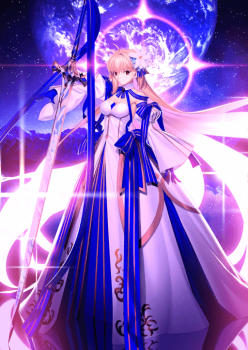Arc has the distinction of being an AoE Buster Servant whose loop setups are not exactly like everyone else’s. Let’s jump into it, shall we?
Let’s start with Arc’s truly unique setup: with Koyan/Arc/Koyan and the Atlas mystic code, Arc can tri-loop CEless. On turn 1, Arc uses her first two skills. On turn 2, you use the Koyan batteries. On turn 3, you use Atlas’s cooldown reduction skill and use Arc’s skills again. If you need more damage on turn 2 and can afford less damage on turn 1, you can save Arc’s first skill for turn 2 and still have it up again on turn 3. In fact, you can actually just use skill 1 twice on turn 2, should you really need it, though odds are good you’ll be more in need of the attack on turn 3. That said, that’s not necessarily always true. If the wave 3 enemies are Chaotic or Man and the wave 2 enemies are not, or if you’re looking at, say, an x/x/1 node where Arc can crit down the last enemy with a card or two, dealing substantially increased damage to everything on the second wave may be worthwhile. Furthermore, it can be smart sometimes to offload low-damage-roll risk from turn 2 to turn 3, as failing to kill on turn 3 usually only costs you a turn or two of cards, where failing to kill on turn 2 has you rolling into wave 3 without all of your buffs active, which can easily drag the fight out to a second buff cycle in high-HP nodes. All this is to say, sometimes you may want to double-stack Arc’s defense down on turn 2, so don’t forget that’s an option.
If you happen to have an Edison, you can squeeze out a bit of extra damage with him and plug. For this setup, you want to run Koyan/Arc/Edison/Koyan, or Koyan/Arc/Koyan/Edison, depending on when you want to use Arc’s skill 1. You can actually use it on any two turns (though you can’t double-stack it on turn 2 this time), but it changes the skill order slightly. With frontline Edison, you use Arc’s skill 1 on turn 1, and then you have it up again by turn 2 to use either there or the turn after. If you start with frontline Koyan, you have much lower turn 1 damage, but then you can use Arc’s skill 1 on both turns 2 and 3, since you’re plugging Edison in on turn 2 and getting his cooldown reduction there. The Edison setup also gives you an extra damage buff from whichever plugsuit you’re running, giving you another option for pushing Arc’s damage on a wave where she doesn’t have niche or otherwise isn’t hitting hard enough.
Arc actually does have one other CE-less loop setup, though it’s generally less effective, for a few reasons I’ll address in a moment. Regardless, here’s the setup: you run Koyan(or any 50% charger)/Arc/Oberon/Oberon, and you have Mana Loading unlocked on Arc. On turn 1, you use Koyan’s battery and buffs, then plug her for the other Oberon and have both Oberons use their 20% batteries. Ideally you save Arc’s skill 1 for turn 2. On turn 2, Arc uses her battery. On turn 3, you use both Oberons’ 50% batteries, as well as both End of the Dream skills, giving Arc a huge burst of wave 3 damage. The reason this is not recommended is that unlocking Mana Loading costs coins that would be better spent giving Arc more attack. While Arc’s wave 3 damage in this setup will be amazing, wave 2 damage is likely to be an issue. The Edison setup will probably be more reliable overall, especially if it involves an Arc with eight extra levels’ worth of attack.
It’s worth noting that Arc can also loop with a 50% starting NP CE and plug. She can do this with any three 50% chargers—she needs 50% charge on turn 1, uses her own battery on turn 2, and uses the other two chargers’ batteries on turn 3. Obviously you still want two Koyans for this—not only do they bring Buster buffs, but they also let Arc stack her first skill—but for the third charger, Reines, Waver, and Oberon all make good cases. Oberon has the obvious advantages of amping Arc’s wave 3 damage and being able to work with a 30% charge CE (that is to say, a non-MLB event CE). Reines and Waver, though, are Living Humans, which means they can actually get their NPs off with Arc’s help. Assuming Reines or Waver is on the field the entire time Arc is looping, they get 70% charge from Arc alone by turn 3: 20% from each of the first two NPs, and 30% from Arc’s skill 3. This is enough for both to NP without any starting charge with the help of Mana Loading and their own skills. Furthermore, since we’re assuming starting charge for Arc anyway, there’s a good chance we have an event CE with starting charge that our supports can also benefit from, which means Reines and Waver will likely have NP access by turn 2, giving you the flexibility to use their NPs earlier if you need more damage on turn 2 instead of turn 3. Things to consider.
Note that the only real reason to run a 50% charge CE on Arc is if it’s an event CE—if you’re using a CE solely to help Arc farm more effectively, you’re better off bringing the Black Grail for additional damage, or bringing a more conventional Buster Servant who has higher damage, if you have one.
Also note that, since damage output is Arc’s biggest limiting factor, you may benefit from working Crane into any of these setups. Crane gets free access to her own NP and provides extra damage buffs that can help Arc hit thresholds she wouldn’t otherwise be able to. Unfortunately, this runs into cost issues, and none of the plug setups will be able to run Crane while also putting a 5* CE on everyone as long as the cost cap remains where it is. If you’re farming with 3* or 4* CEs, though (for event currency, for example), it’s an option. It’s also an option for the Atlas setup, though adding Crane in sorta defeats the purpose of not using plug, and an NP1 Crane is pretty much the same damage output as Edison with the plug buff, with higher team cost and lower flexibility. If we ever get a bronze Servant with CDR who we can use in place of Edison, it would be worth adding Crane into that setup, but as-is, her value is somewhat restricted.
I would also be remiss to not acknowledge Summer Proto Merlin, who will be releasing soon. If her Arcade version is any indication, she may bring cooldown reduction in her kit, in which case she might be a better farming option than Edison depending on how accessible that CDR effect is. If it’s tied to her NP and she doesn’t have enough batteries to use the NP in Arc teams, she’d be out of luck, but if it’s on a skill or she has a Crane-style self battery, she’d very likely bring more damage than Edison does.
For CQs, all of the above strategies are workable burst options, though when you’re allowed cards, Arc’s unique advantages stop mattering as much, and it becomes harder to justify bringing her over someone with more damage. Arc’s CQ strengths lie mostly in stall contexts. Arc is one of the best Buster Servants to run in a Reines/Castoria shell, as Arc provides a ton of charge to her allies, helping to keep the team’s defenses up consistently. In a Reines->Arc->Castoria NP chain, Reines’s overcharge buff brings Arc up to OC3, funneling 30% charge right back to Reines to get her moving towards the next set of NPs. Arc’s third skill is also a great emergency tool here, providing an extra defensive stack on top of Castoria’s defenses and also helping to charge Reines’s and Castoria’s NPs. Very nice.
As I mentioned earlier, Reines is not Good-aligned, so in fights where buff removal is a danger, consider swapping her for Merlin or Himiko. Merlin provides a little less defense but will help the team move faster and has healing to help keep them alive, and Himiko maximizes Castoria’s defenses while also bringing some nice crit damage buffs the whole team likes.
Something to keep in mind when running Castoria stall with Arc is that if Arc has her battery available and gets her NP a turn early—that is to say, a turn before Castoria’s Solemn Defense has worn off, when you’re not ready for the next full NP chain—Arc can sneak in some extra damage by using her NP and then letting her battery charge her back to full on the next turn. It’s a nice extra luxury, so don’t forget to take advantage of it when you can.
Arc is a highly self-sufficient unit, so if you don’t have the tools for optimal Arc play, you can also run her with whichever budget supports you do have. Even something very oldschool like Mash/Arc/Merlin will work pretty well. Mash is even considered a Living Human, so Arc will substantially speed up Mash’s NP cycling. Waver is also a good option in place of Merlin, if you don’t have Merlin and don’t want to rely on finding one off your friend list, in part because Arc gives her Living Human charges to him as well. Jinako is another great partner for Arc in lower-end play, providing lots of protection while, again, benefiting from Arc’s charges. And then there are the old standby budget Servants like Hans, Barti, Chen, and Shakespeare, who are as good as ever.
Assuming you’re not running an event CE, the Black Grail is Arc’s best farming CE, as it mostly solves her damage issues. If you don’t have the Black Grail, Heaven’s Feel is nearly as good, with CEs like Limited/Zero Over a bit further behind. For CQs, the Black Grail is a bit dangerous—Arc stall teams that don’t involve Merlin likely have no healing, in which case the demerit can add up over time. Arc’s damage is still concentrated on her NP, though, so Heaven’s Feel is a good choice. Depending on the team, you might want a starting charge CE like Golden Sumo or Aerial Drive instead, so Arc doesn’t have to use her battery on the first turn and can save it for a free NP later.
For CCs, Arc has a lot of options. Without any in-kit star weight tools and with only Independent Action for a crit buff, crit damage up CCs and star weight up CCs will both go a long way. Unfortunately, you’re stuck with one or the other on any given card, which mostly just means Arc isn’t much of a crit unit. If anything, I’d put crit damage CCs on Arc’s Busters to pair with Koyan’s Buster crit buffs. Aside from that, healing CCs are an option for a bit more stability when stalling, and NP damage up CCs can provide a way to push damage a little in a pinch.

 4
4 4
4 3
3 5
5 4
4
































